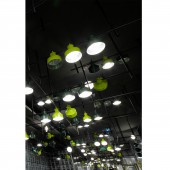Hong Kong Day Restaurant by ONE PLUS PARTNERSHIP LIMITED |
Home > Winners > #51007 |
 |
|
||||
| DESIGN DETAILS | |||||
| DESIGN NAME: Hong Kong Day PRIMARY FUNCTION: Restaurant INSPIRATION: Hong Kong Day is a restaurant serving Hong Kong style food. As stated clearly in the name of the restaurant, Hong Kong Day strives to create an atmosphere where customers can have a Hong Kong style experience. The designers chose “Mahjong” to be the theme of this design, as a representation of Hong Kong culture. Mahjong is a traditional Chinese game that Hong Kong people enjoy a lot, we play Mahjong when having parties, dinner gatherings, during festivals, etc. It is a means of socializing and having fun, regardless of the players’ age and generation. It is an exciting game that demonstrates Hong Kong’s traditional energetic festive atmosphere. UNIQUE PROPERTIES / PROJECT DESCRIPTION: Mahjong is a traditional game that Hong Kong people enjoy in gatherings, it is chosen to represent Hong Kong culture. Different shades of green subtly resemble Mahjong tiles, and circle tiles are used as a recurring motif through furniture and decorations. In Mahjong, there are many combinations in the number of tiles, reflected in the grouping of spotlights and mosaic hexagonal floor patterns. OPERATION / FLOW / INTERACTION: - PROJECT DURATION AND LOCATION: Hong Kong |
PRODUCTION / REALIZATION TECHNOLOGY: Fabric, Corian solid surfacing material, stainless steel, mosaic, plastic laminate SPECIFICATIONS / TECHNICAL PROPERTIES: 270 sq. meter TAGS: Restaurant, Hong Kong, mahjong, culture, social, interaction, zinc RESEARCH ABSTRACT: - CHALLENGE: The theme of Mahjong had in fact been adopted in many restaurant designs before, the designers had to create a design that is unconventional and subtly present the theme. The designers did not want to directly apply Mahjong patterns to the restaurant design. As the design was original, the designers had to custom-make furniture and decorations. ADDED DATE: 2016-09-30 18:44:38 TEAM MEMBERS (1) : ONE PLUS PARTNERSHIP LIMITED IMAGE CREDITS: Ajax Law & Virginia Lung PATENTS/COPYRIGHTS: Copyrights belong to One Plus Partnership Limited, 2016. |
||||
| Visit the following page to learn more: http://www.onepluspartnership.com/ | |||||
| AWARD DETAILS | |
 |
Hong Kong Day Restaurant by One Plus Partnership Limited is Winner in Interior Space and Exhibition Design Category, 2016 - 2017.· Read the interview with designer ONE PLUS PARTNERSHIP LIMITED for design Hong Kong Day here.· Press Members: Login or Register to request an exclusive interview with ONE PLUS PARTNERSHIP LIMITED. · Click here to register inorder to view the profile and other works by ONE PLUS PARTNERSHIP LIMITED. |
| SOCIAL |
| + Add to Likes / Favorites | Send to My Email | Comment | Testimonials | View Press-Release | Press Kit |
Did you like One Plus Partnership Limited's Interior Design?
You will most likely enjoy other award winning interior design as well.
Click here to view more Award Winning Interior Design.








